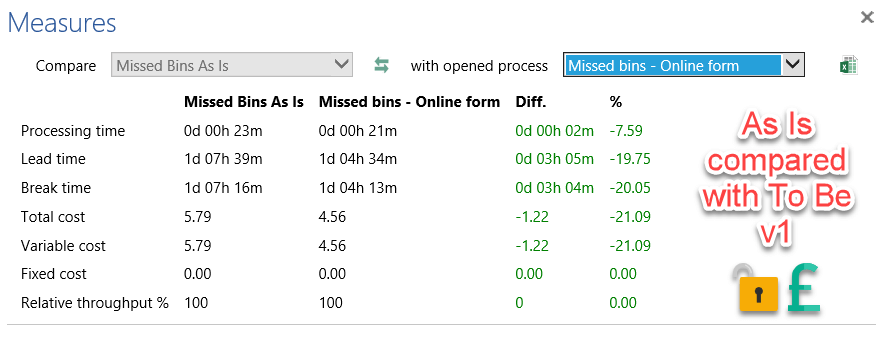Process Improvement – Its all about the benefits

How about if you could easily see the benefits of your process improvement work? Would that help your organization make better changes? Well it can be done and it can be done easier, faster and cheaper than by using your current process mapping approach.
 If I had a pound for every time an analyst or PM or any other role said to me “we are not very good at the benefits side of change” I would be a very rich man.
Ultimately no matter what approach we are taking to process improvement, the benefits of the change are one of the most important things to get right and by that I mean understood. We are not applying Agile, Lean, Waterfall, Design Thinking, Lean Start Up, Six Sigma or Kata (to name but a few approaches) to our organisations services, systems and processes as an academic exercise. Ultimately, we are trying to get an outcome or outcomes and these generally relate directly to benefits.
To be able to quantify, measure and understand those benefits helps us massively with many other aspects of the delivery process.
In the Public Sector, we are trying to improve our processes to deliver better for user needs in a more efficient way so that we can protect or improve services. We are looking to be more efficient to allow us to focus scarce resources on the customer/patient value.
In the Private Sector we are trying to produce better services faster and easier for our customers at better prices to allow us to grow and scale our business. There is not a lot of difference in reality they are both trying to improve their processes to deliver better outcomes.
Effectively we run projects and programmes to continuously improve and iterate our processes and services (or at least we should be). Both the Public Sector and the Private Sector cases are very similar in that we hope to achieve varying tangible and intangible benefits of a result of change/improvement initiatives.
If I had a pound for every time an analyst or PM or any other role said to me “we are not very good at the benefits side of change” I would be a very rich man.
Ultimately no matter what approach we are taking to process improvement, the benefits of the change are one of the most important things to get right and by that I mean understood. We are not applying Agile, Lean, Waterfall, Design Thinking, Lean Start Up, Six Sigma or Kata (to name but a few approaches) to our organisations services, systems and processes as an academic exercise. Ultimately, we are trying to get an outcome or outcomes and these generally relate directly to benefits.
To be able to quantify, measure and understand those benefits helps us massively with many other aspects of the delivery process.
In the Public Sector, we are trying to improve our processes to deliver better for user needs in a more efficient way so that we can protect or improve services. We are looking to be more efficient to allow us to focus scarce resources on the customer/patient value.
In the Private Sector we are trying to produce better services faster and easier for our customers at better prices to allow us to grow and scale our business. There is not a lot of difference in reality they are both trying to improve their processes to deliver better outcomes.
Effectively we run projects and programmes to continuously improve and iterate our processes and services (or at least we should be). Both the Public Sector and the Private Sector cases are very similar in that we hope to achieve varying tangible and intangible benefits of a result of change/improvement initiatives.

 Being good at benefits realisation and management is definitely a skillset I would like in my organisation. Understanding what the customer and organisational benefits are and how we are improving them is unquestionably a good thing (feel free to comment if you disagree). We don’t think this is the only tool but it certainly helps us deliver better against our goals.
Being good at benefits realisation and management is definitely a skillset I would like in my organisation. Understanding what the customer and organisational benefits are and how we are improving them is unquestionably a good thing (feel free to comment if you disagree). We don’t think this is the only tool but it certainly helps us deliver better against our goals.
 There are a number of tools that can help you deliver the process capture, understanding, costing and continuous improvement process better like the one offered by us see the blog here. These tools help you capture and understand your processes live in a workshop. The maps/models contain your times and can calculate the cost of process. They also help you identify bottlenecks and help you identify improvement ideas.
With better tools you can start to look at how you can not only be capturing and understanding benefits but also embedding the skills in your organisation so your teams can be delivering continuous improvement. Edinburgh City Council have trained over 200 people from across the entire organisation to be delivering continuous improvement.
There are a number of tools that can help you deliver the process capture, understanding, costing and continuous improvement process better like the one offered by us see the blog here. These tools help you capture and understand your processes live in a workshop. The maps/models contain your times and can calculate the cost of process. They also help you identify bottlenecks and help you identify improvement ideas.
With better tools you can start to look at how you can not only be capturing and understanding benefits but also embedding the skills in your organisation so your teams can be delivering continuous improvement. Edinburgh City Council have trained over 200 people from across the entire organisation to be delivering continuous improvement.
 If I had a pound for every time an analyst or PM or any other role said to me “we are not very good at the benefits side of change” I would be a very rich man.
Ultimately no matter what approach we are taking to process improvement, the benefits of the change are one of the most important things to get right and by that I mean understood. We are not applying Agile, Lean, Waterfall, Design Thinking, Lean Start Up, Six Sigma or Kata (to name but a few approaches) to our organisations services, systems and processes as an academic exercise. Ultimately, we are trying to get an outcome or outcomes and these generally relate directly to benefits.
To be able to quantify, measure and understand those benefits helps us massively with many other aspects of the delivery process.
In the Public Sector, we are trying to improve our processes to deliver better for user needs in a more efficient way so that we can protect or improve services. We are looking to be more efficient to allow us to focus scarce resources on the customer/patient value.
In the Private Sector we are trying to produce better services faster and easier for our customers at better prices to allow us to grow and scale our business. There is not a lot of difference in reality they are both trying to improve their processes to deliver better outcomes.
Effectively we run projects and programmes to continuously improve and iterate our processes and services (or at least we should be). Both the Public Sector and the Private Sector cases are very similar in that we hope to achieve varying tangible and intangible benefits of a result of change/improvement initiatives.
If I had a pound for every time an analyst or PM or any other role said to me “we are not very good at the benefits side of change” I would be a very rich man.
Ultimately no matter what approach we are taking to process improvement, the benefits of the change are one of the most important things to get right and by that I mean understood. We are not applying Agile, Lean, Waterfall, Design Thinking, Lean Start Up, Six Sigma or Kata (to name but a few approaches) to our organisations services, systems and processes as an academic exercise. Ultimately, we are trying to get an outcome or outcomes and these generally relate directly to benefits.
To be able to quantify, measure and understand those benefits helps us massively with many other aspects of the delivery process.
In the Public Sector, we are trying to improve our processes to deliver better for user needs in a more efficient way so that we can protect or improve services. We are looking to be more efficient to allow us to focus scarce resources on the customer/patient value.
In the Private Sector we are trying to produce better services faster and easier for our customers at better prices to allow us to grow and scale our business. There is not a lot of difference in reality they are both trying to improve their processes to deliver better outcomes.
Effectively we run projects and programmes to continuously improve and iterate our processes and services (or at least we should be). Both the Public Sector and the Private Sector cases are very similar in that we hope to achieve varying tangible and intangible benefits of a result of change/improvement initiatives.

Even if you are not being asked about the benefits of process improvement currently, you should still want to know
I have worked in and with many organisations where they are not currently being asked “what are the benefits?”. It is in one way a lucky position but I would argue that often it is only a temporary break from that challenge. It is rare with a project, new software or really any other change there will come a point where someone asks “We spent £x so what did we gain?” I don’t think we should try to avoid quantifying benefits. I think it is critical to successfully delivering any project or programme. How do we decide what to do? We understand our current pipeline of projects for costs/benefits/effort and prioritise the improvements that deliver greatest bang for your buck. Obviously, there are other drivers sometimes for priorities but where there are not then a benefits driven approach will definitely help (I would argue even when another priority drives a project to the top it is still useful its cost/benefits/effort). Process improvement is a vital tool in the toolbox in delivering change and understanding the benefits helps facilitate many other elements in your change pipeline. Being good at benefits realisation and management is definitely a skillset I would like in my organisation. Understanding what the customer and organisational benefits are and how we are improving them is unquestionably a good thing (feel free to comment if you disagree). We don’t think this is the only tool but it certainly helps us deliver better against our goals.
Being good at benefits realisation and management is definitely a skillset I would like in my organisation. Understanding what the customer and organisational benefits are and how we are improving them is unquestionably a good thing (feel free to comment if you disagree). We don’t think this is the only tool but it certainly helps us deliver better against our goals.
But why is it so hard to quantify these process improvement benefits?
http://www.weareleanandagile.com/wp-content/uploads/2019/08/Are-you-ready-for-the-Lean-Process-Suite.pdf The traditional tools for process improvement do not add much value. You need to get people together and map with sticky notes. Someone then needs to spend a lot of time writing up the process into a mapping tool. You also need to capture the notes and the data into another medium. At some point you need to try to calculate the times and costs and also start to work out improvements and their benefits. All of the above is difficult and takes a long time. It is not engaging for stakeholders as the sticky note map they created turns into an electronic version which is different. There are long delays in the process and everything is manually calculated and collected in multiple different data sources. Because of these difficulties you tend to need specialist business analysts to deliver these improvement interventions. You may have some business analysts in your organisation (although probably not enough to deliver continuous improvement) but also you may need to bring in external consultants.There are better process improvement tools
 There are a number of tools that can help you deliver the process capture, understanding, costing and continuous improvement process better like the one offered by us see the blog here. These tools help you capture and understand your processes live in a workshop. The maps/models contain your times and can calculate the cost of process. They also help you identify bottlenecks and help you identify improvement ideas.
With better tools you can start to look at how you can not only be capturing and understanding benefits but also embedding the skills in your organisation so your teams can be delivering continuous improvement. Edinburgh City Council have trained over 200 people from across the entire organisation to be delivering continuous improvement.
There are a number of tools that can help you deliver the process capture, understanding, costing and continuous improvement process better like the one offered by us see the blog here. These tools help you capture and understand your processes live in a workshop. The maps/models contain your times and can calculate the cost of process. They also help you identify bottlenecks and help you identify improvement ideas.
With better tools you can start to look at how you can not only be capturing and understanding benefits but also embedding the skills in your organisation so your teams can be delivering continuous improvement. Edinburgh City Council have trained over 200 people from across the entire organisation to be delivering continuous improvement.
The benefits of a benefits driven approach
http://www.weareleanandagile.com/wp-content/uploads/2019/08/Are-you-ready-for-the-Lean-Process-Suite.pdf It is vitally important to understand benefits of change through process improvement whether you are in the public or private sector. I would argue it is the sort of thing you should consider doing before going out and buying that new bit of software or tool that helps solve the problems you do not yet understand.- If you don’t understand the benefits of change how do you prioritise your change pipeline?
- If you don’t understand the benefits how do you understand what works and what doesn’t?
- Without understanding benefits how do you decide to invest in new technology to improve your process delivery?
- If you don’t understand benefits now and are not asked be aware this is likely to be a temporary reprieve at some point someone will most likely ask so what?
